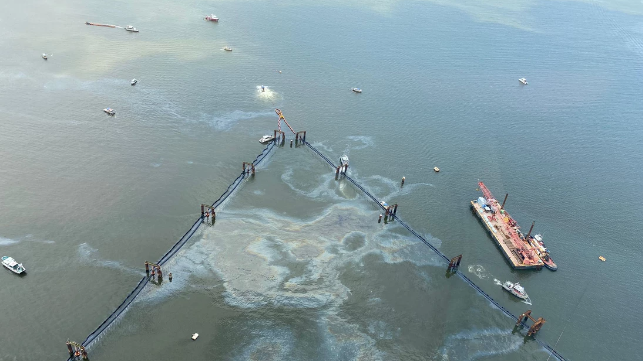Golden Ray Wreck Continues to Spill Fuel Oil

Salvage teams on the Golden Ray wreck removal project continue to deal with fuel oil spills as they gradually raise the latest section of the vessel's hull out of the water.
Spillage began Saturday when the team began hoisting, which is usually accompanied by responders washing sediment out of the hull section to shed weight. It was the largest spill yet experienced during the salvage project, and tidal flows flushed an unknown quantity of oil out of the work site containment barrier and into St. Simons Sound. Significant oiling was observed on beaches and marshland on St. Simons Island and Jekyll Island, and additional cleanup personnel were called in to remove pollution from the shoreline.
 Mitigation efforts near section six after spillage on Wednesday (St. Simons Sound Incident Response)
Mitigation efforts near section six after spillage on Wednesday (St. Simons Sound Incident Response)
On Wednesday morning, wreck removal personnel once again partially raised the sixth section. An oil discharge began to pool inside of retention boom around the section, and the salvage master paused the lifting operation to allow oil skimmers in with a floating vacuum system to pump out fuel oil floating on the surface. Some oil escaped beyond the perimeter barrier, and about 30 pollution control vessels were on hand to respond.
“We are executing very controlled lifts of Section Six in order to recover any oil that discharges from the section without overwhelming our multi-layered mitigation system,” said Incident Commander Chris Graff of Gallagher Marine Systems. “Removing this section will take time and we appreciate the patience and support of the community as we move forward.”
The salvage command said that lifting operations will be limited to conditions that are favorable for safety and spill control.
About 80 people have been assigned to cleanup duty along the beaches of St. Simons Island, including popular swimming and sunbathing spots. The beaches remain open to the public, and Georgia's Department of Health has recommended that beach-goers remain vigilant. To control the damage, the teams are collecting up oiled sand and applying sphagnum moss and sorbent pads to oiled marsh grasses.
 Response teams apply sphagnum moss to oiled marsh grasses, St. Simons Island (St. Simons Sound Incident Response)
Response teams apply sphagnum moss to oiled marsh grasses, St. Simons Island (St. Simons Sound Incident Response)
A wildlife assessment team from the Georgia Department of Natural Resources spotted a small number of oiled juvenile Royal terns on Bird Island on Wednesday, but did not attempt to recover them. The team will keep monitoring for wildlife impacts.
Fletcher Sams, the executive director of environmental group Altamaha Riverkeeper, told AP that he would like to see a Natural Resources Damage Assessment (a federal study typically performed by NOAA) to determine the cumulative impact of the Golden Ray grounding. "The natural resources of the area have been continuously damaged for two years almost," he told AP.
